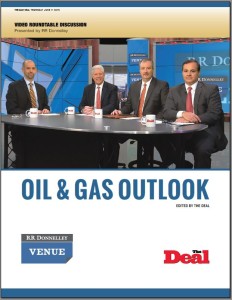Issuing its third bankruptcy ruling in a month, the Supreme Court held, by a 6-3 margin, that the Bankruptcy Code does not permit awarding fees to debtor’s counsel, when counsel incurred those fees defending its own fee application. The Court held that services defending fee applications were not rendered to the debtor’s estate, and therefore the fees did not constitute “actual, necessary services” payable under section 330(a)(1) of the Bankruptcy Code as reasonable compensation. This decision could increase leverage on parties seeking to rein in bankruptcy litigation by threatening to challenge attorney’s fees. Baker Botts L.L.P. et al. v. ASARCO LLC, No. 14-103, 2015 WL 2473336 (S. Ct. June 15, 2015) (hereinafter, the “Opinion”).
2015 Oil & Gas Outlook Follow-Up Report
 Orrick’s Restructuring Practice Chair, Raniero D’Aversa, recently sat on The Deal Pipeline’s expert panel, a 60 minute round table which addressed the present issues in the oil and gas industry and provided viewers with an insight into the key factors for their success in 2015.
Orrick’s Restructuring Practice Chair, Raniero D’Aversa, recently sat on The Deal Pipeline’s expert panel, a 60 minute round table which addressed the present issues in the oil and gas industry and provided viewers with an insight into the key factors for their success in 2015.
Please click here here for this follow-up report.
A Battle in the Making in the Oil and Gas Sector: Second Lien vs. High Yield Debt
In the oil and gas industry, there is a storm brewing between holders of second lien debt and unsecured high yield bonds. These creditor groups are finding themselves pitted against one another as oil and gas companies become increasingly leveraged in an effort to alleviate liquidity constraints.
As widely publicized, oil prices precipitously decreased in 2014 and depressed prices have continued into 2015, with prices falling from $103 per barrel a year ago to around $60 per barrel today. With this prolonged decline and period of weak oil prices, oil and gas companies are having difficulty breaking even. Therefore, it is not surprising that many industry players, particularly the upstream division (comprised of exploration and production activities), have experienced tightened liquidity. Larger and well-diversified companies are best equipped to weather the storm because they are able to rationalize liquidity by suspending new projects and future exploration, selling non-core/non-producing assets and demanding price reductions from service providers. While these measures have helped ease some financial stress, they are often not enough and companies have turned to the debt capital markets as a source of liquidity. These new financings provide companies with much needed time to either wait out this period of depressed oil prices or formulate a restructuring plan.
Supreme Court Says Underwater Junior Liens Survive Bankruptcy
On March 30, we reported on two cases pending before the U.S. Supreme Court: Bank of America v. Caulkett[1] and Bank of America v. Toledo-Cardona[2]. Each involved chapter 7 bankruptcy cases in which the debtors had no equity in their homes because the houses were worth less than the amount outstanding on the senior mortgage loans—that is, the second lien-lenders were “unsecured” or totally “underwater”.
In a chapter 7 case, an individual debtor is able to obtain a discharge of his or her debts, but the debtor’s non-exempt assets are liquidated by a bankruptcy trustee, who then distributes the proceeds to creditors. In Dewsnup v. Timm[3], the Supreme Court held that Bankruptcy Code § 506 does not permit an individual chapter 7 debtor to reduce (or “strip down”) a first-lien mortgage loan to the value of the real property where the amount owed ($119,000) is greater than the property value ($39,000). Caulkett and its companion case addressed whether the outcome should be different where the debtor seeks to void (or “strip off”) a second lien mortgage that is wholly underwater.
On its decision announced on June 1, the Supreme Court found the question effectively controlled by its prior holding in Dewsnup. Noting that the debtors had not asked it to overrule Dewsnup, the Court held by unanimous decision[4] that a debtor in a chapter 7 bankruptcy case may not void second mortgage liens under Bankruptcy Code section 506(d) when the debt owed on a senior mortgage lien exceeds the current value of the collateral. The Court rejected respondents’ attempts to limit Dewsnup’s interpretation to partially underwater mortgages, concluding that there was no principled way to distinguish those from wholly underwater mortgages within the terms of the Bankruptcy Code. In Dewsnup, the Court defined an “allowed secured claim” under section 506(d) as “claim supported by a security interest in property, regardless of whether the value of that collateral would be sufficient to cover the claim”. Thus, section 506(d) voids underwater liens only where the underlying debt is invalid under applicable law.
Orrick Ranked Among Top Ten Bankruptcy Law Firms
 Orrick has been ranked a Top Ten Bankruptcy Law Firm by The Deal Pipeline. These rankings are compiled on a quarterly basis through comprehensive deal intelligence to identify the top law, crisis management, investment, and non-investment firms and professionals involved in bankruptcy transactions throughout the United States.
Orrick has been ranked a Top Ten Bankruptcy Law Firm by The Deal Pipeline. These rankings are compiled on a quarterly basis through comprehensive deal intelligence to identify the top law, crisis management, investment, and non-investment firms and professionals involved in bankruptcy transactions throughout the United States.
Recent highlights for Orrick’s restructuring team include advising the City of Stockton, California on the confirmation of its chapter 9 plan of adjustment and its successful exit from bankruptcy; representing the bidding lenders in a potential $400 million post-petition DIP financing for the City of Detroit; and advising several of the world’s largest banks in the $6 billion restructuring of the Indiana Toll Road—the largest toll-road debt restructuring to date. For their work on these and other matters, the Orrick team was recognized by Law360 as one of the publication’s Bankruptcy Practice Groups of the Year.
To see the full list of rankings, please click here.
Enforceability of Oral Contracts for Loan and Claim Trades
The Loan Syndications and Trading Association (the “LSTA”) scored a major victory in 2002 when New York adopted LSTA-sponsored legislation designed to make oral agreements to trade bank loans and claims arising from business debts legally binding. Since then, participants in both the syndicated loan market and the claims trading market have come to rely upon the idea that trades entered over the phone are binding, so long as the parties agreed to the material terms of the trade.
A 2014 Fifth Circuit Court of Appeals decision calls this assumption into question for loan trading, and a case that is currently pending in New York state court could extend the uncertainty to business debt claim trades as well.
Supreme Court Removes Cloud Over Bankruptcy Judges’ Powers, But Creditors Need To Remain Vigilant
On February 23, we reported on a case pending before the U.S. Supreme Court: Wellness International Network, Limited v. Sharif. On May 26, the Supreme Court in Wellness held that parties may waive their right to have certain claims decided by a court other than a Bankruptcy Court and that the waiver need not be express. It can be implied as a result of a litigant’s conduct. No. 13-935, 575 U.S. ___ (2015).
2015 Oil and Gas Outlook Webcast
 The recent dip in oil prices has set many leading oil and gas companies into situations of financial distress, which could lead to increased deal flow in the second half of the year as these companies are faced with a need to sell assets.
The recent dip in oil prices has set many leading oil and gas companies into situations of financial distress, which could lead to increased deal flow in the second half of the year as these companies are faced with a need to sell assets.
On May 19th, Orrick’s Restructuring Practice Chair, Raniero D’Aversa, sat on The Deal Pipeline’s expert panel, a 60 minute round table which addressed these issues in the oil and gas industry and provided viewers with an insight into the key factors for their success in 2015.
This webcast is available for viewing here.
Overview and Analysis of Select Provisions of the ABI Chapter 11 Reform Commission Final Report and Recommendations
Part Three of Three
Earlier this year, Orrick’s Restructuring team began a three-part look at the American Bankruptcy Institute’s Chapter 11 Reform Report. In part one we looked at issues related to confirmation, valuation, financing and asset sales. Last month, in part two, we focused on modifications to the Bankruptcy Code’s “safe harbors” for derivatives and other complex financial transactions. This final part focuses on a variety of critical issues: third party releases, rejection of collective bargaining agreements, professional compensation issues and treatment of executory contracts in bankruptcy.
To view part three, please click here.
A Stop to PIK Loans from the Court of Milan
PIK (Payment In Kind) loans are loans that typically do not provide for any cash flows from borrower to lender between the drawdown date and the maturity/refinancing date. In PIK loans, interests generally accrue period after period, thus increasing the underlying principal. As an alternative, PIK Loans may include provisions according to which, upon the occurrence of certain events, interest payments due by the debtor become undue and the corresponding amount is added to the principal amount, so that it generates further interests. This latter type of provisions is usually included in loans granted in the context of restructuring proceedings where the borrower may not always be able to meet, in whole or in part, its obligations to pay the agreed interests as they become due.

